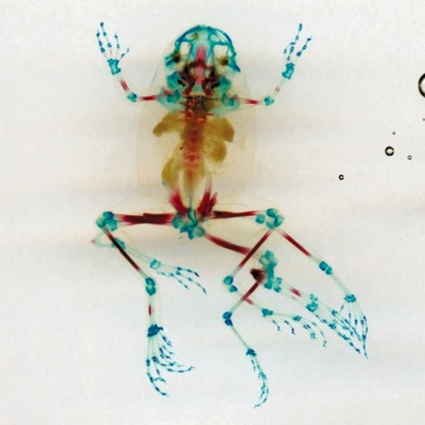So, I said I was going to do the flying silkworms this week. However, seeing as this week's theme will be frogs, change of plans. Frogs are one of science's most common organisms; of course somebody has done scientific art with them. Creepy, cool scientific art.
Malamp features specially-stained frog skeletons...gone horribly, horribly wrong. Some are missing legs. Others have far too many legs. The culprits are usually parasites like Ribeiroia or dragonfly nymphs, which, much like French and Vietnamese, find frog legs delicious. The result is either frogs with limbs missing or frogs with too many legs. Way too many legs.
Ecological artist Brandon Ballengée specializes in amphibian deformities. Freaky frogs are on every continent with frogs; Ballengée has been tracking them extensively in Europe and the U.S., where they are particularly abundant. Amphibians with crazy limbs can be found almost everywhere in the U.S. and are only getting more plentiful. We get frogs with multiple limbs while frogs lose limbs in the rest of the world.
Ballengée, in cooperation with Arts Catalyst, was commissioned to turn his passion for deformed amphibians into art in 1996. The stain he uses on the skeletons for the project coats cartilage in blue and bone in red. The images are then printed and put on display for all to see. The actual skeletons are backlit below them. Few things are crazier than a frog with twenty legs and a cool paintjob.
This is, however, only half the project. The other part is actually going out with people and collecting the little froggies. This gives the general public a look at tadpoles as they've never seen them before: as freaky, swimming indicators of environmental health. You will be hearing a lot about how fragile amphibians can be this week, so I will only mention it once here. The art speaks for itself.
Malamp was installed in Turin, Italy in 2010, but has also been in Cincinnati. There will probably be an announcement if the multi-limbed, glowing frogs ever make their way to you. You'd think something like that would wind up on the news.
Malamp features specially-stained frog skeletons...gone horribly, horribly wrong. Some are missing legs. Others have far too many legs. The culprits are usually parasites like Ribeiroia or dragonfly nymphs, which, much like French and Vietnamese, find frog legs delicious. The result is either frogs with limbs missing or frogs with too many legs. Way too many legs.
 |
| The third leg is nothing... |
Ecological artist Brandon Ballengée specializes in amphibian deformities. Freaky frogs are on every continent with frogs; Ballengée has been tracking them extensively in Europe and the U.S., where they are particularly abundant. Amphibians with crazy limbs can be found almost everywhere in the U.S. and are only getting more plentiful. We get frogs with multiple limbs while frogs lose limbs in the rest of the world.
Ballengée, in cooperation with Arts Catalyst, was commissioned to turn his passion for deformed amphibians into art in 1996. The stain he uses on the skeletons for the project coats cartilage in blue and bone in red. The images are then printed and put on display for all to see. The actual skeletons are backlit below them. Few things are crazier than a frog with twenty legs and a cool paintjob.
 |
| The video lied: I only count 6 legs! Art (c) Ballengee, but it's very cool. |
This is, however, only half the project. The other part is actually going out with people and collecting the little froggies. This gives the general public a look at tadpoles as they've never seen them before: as freaky, swimming indicators of environmental health. You will be hearing a lot about how fragile amphibians can be this week, so I will only mention it once here. The art speaks for itself.
Malamp was installed in Turin, Italy in 2010, but has also been in Cincinnati. There will probably be an announcement if the multi-limbed, glowing frogs ever make their way to you. You'd think something like that would wind up on the news.



No comments:
Post a Comment